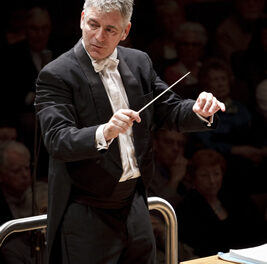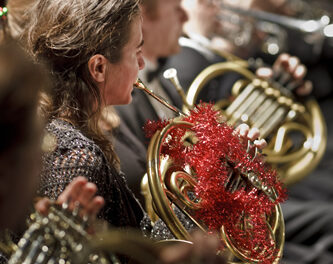Owens Auditorium at Sandhills Community College, the gem-like educational institution that has provided staff for many of the world’s most beautiful golf courses, parks, and historic sites, reopened with a gala concert on a brisk Friday evening; the program will be repeated on Nov. 9.
The hall itself was built in 1988. It was, as a spokesperson for the school told us, a 700-seat room that was basically not a whole lot of good for much more than large classes. There’s no overhang, the sightlines are good, and the acoustics (as experienced at this grand opening) are excellent. Its reopening signals more than a mere part of a $4.5 million renovation: it’s in fact a complete transformation from a utilitarian space to a quite spectacular concert room that is in turn part of a newly reimagined center – the Bradshaw Performing Arts Center – that consists of four key elements: Owens, the 80-seat McPherson black-box theatre, the lovely space between them that is named Evelyn’s Courtyard, and the adjoining McNeill-Woodward Green. Note that all this is in addition to the magnificent botanical gardens that have since 1978 been one of the school’s most noteworthy attractions.
They’ve done this renovation/expansion/enhancement right. In the lobby is a stunning 1875 Bösendorfer grand – an instrument that might well have been used in the concert’s opening piano concerto, which dates from a mere seven years earlier. But instead, the stage was graced with a brand-new Steingraeber & Söhne concert grand – Franz Liszt himself owned one – slick, glistening, beautiful, with sonorous and ample sound, and a joy to hear. (The Bayreuth-based company, established in 1852, 20 years before Wagner laid the foundation of his festival house there, is viewed by some as the Rolls-Royce of piano manufacturers.)
There were informative and engaging welcoming remarks by SCC president John Dempsey, who told about the development of the PAC and the key role played in the planning process by pianist and conductor David Michael Wolff, whose Carolina Philharmonic was a major impetus for the project; he, too delivered remarks, along the way paying tribute to the project’s generous patrons whose vision and commitment led us to this grand occasion. It’s a truly wonderful revamped setting for this altogether admirable little orchestra that plays with precision, passion, and palpable power.
The program consisted of not one but two highly-celebrated concerti – Grieg’s, for piano and orchestra, and Tchaikovsky’s, for violin and orchestra. With the pre-concert reception, the welcoming remarks, and the somewhat extended intermission, these two pieces were a generous plenty – but truth to tell one hungered as well for something with a genuine dedicatory bent, to wit Beethoven’s dramatic “Overture to the Consecration of a House,” Op. 124 (Die Weihe des Hauses). Next time!
The program began with the Grieg Concerto in A Minor, Op. 16, played and conducted (!) by Wolff. He explained how unusual this was: sure enough, one has heard Mozart and even Prokofiev’s Third played and conducted by the same hyperactive soul, but this was unique. He was very, very busy, and there’s little doubt he’ll need that chiropractor he mentioned next week, if not over the weekend.
That it worked so well is a tribute to the pianist and his stalwart assisting artists. The balance was near-perfect, and the playing from the ensemble – 23 strings and 22 other instrumentalists were named in the program – was in every respect splendid. We found the tempi of the first movement somewhat sedate, but the slow movement has rarely made such a compelling impression, and the finale was chock-full of fireworks, alongside its manifold artistic delights. At the end, the place erupted in applause. (In fact, the crowd had erupted at every break in the proceeding, so overflowing with enthusiasm was this audience.)
But there was more, as violinist Natasha Korsakova returned (from a book tour – her second crime novel (!) was released last month) to play the Tchaikovsky Concerto in D, Op. 35 (1878). She’s been here often since her 2014 debut with the Carolina Phil.* and is officially the orchestra’s “artist in residence” (and also at Wolff’s other orchestra, in Leesburg, Orchestra 2100.)
This concerto is one of the classical world’s most dazzling vehicles, a work that has led fans (or fanatics) to argue endlessly the merits of this Heifetz recording or that one, or whether Milstein was warmer than Oistrakh, etc., etc. Set all that aside. We’re unlikely to hear a better version, live, in concert, than the one delivered in beautiful, scenic Pinehurst by Korsakova, Wolff, and Company. The sleek, sinewy orchestra projected confidence aplenty in its vital supporting role, with excellent work from the horns and winds and the brass – all elevated to facilitate their projection into the hall from their places at the back of the stage of this multi-purpose room. But it was the strings, headed by concertmaster Petia Randeva-Manolova,*** that most impressed, with their incisive playing, immaculate phrasing, and heart-warming ensemble, overall. So it was good, it was very good, it was very, very good, and at the end it was spectacular. The place went wild. Again. And at the end, there was an encore, the “Meditation” from Massenet’s Thaïs, played by Korsakova with Wolff at the piano (bringing the new instrument back to the forefront*** at the end) and with loving support from the members of the Carolina Phil. As someone once famously said, “Bravo tutti!” Sandhills has a real PAC now, and it’s had a real orchestra for a decade. Let’s all join together to welcome – and to support! – both!
See the sidebar for details of the repeat of this program on Nov. 9.
*Her recital debut in Raleigh in 2014, two days after her first appearance in Pinehurst, was reviewed here.
**She succeeded the much-loved, deeply lamented Yang Xi upon his untimely death last spring.
***The piano had remained on-stage for the violin concerto, so folks had suspected an encore of some sort all along….













